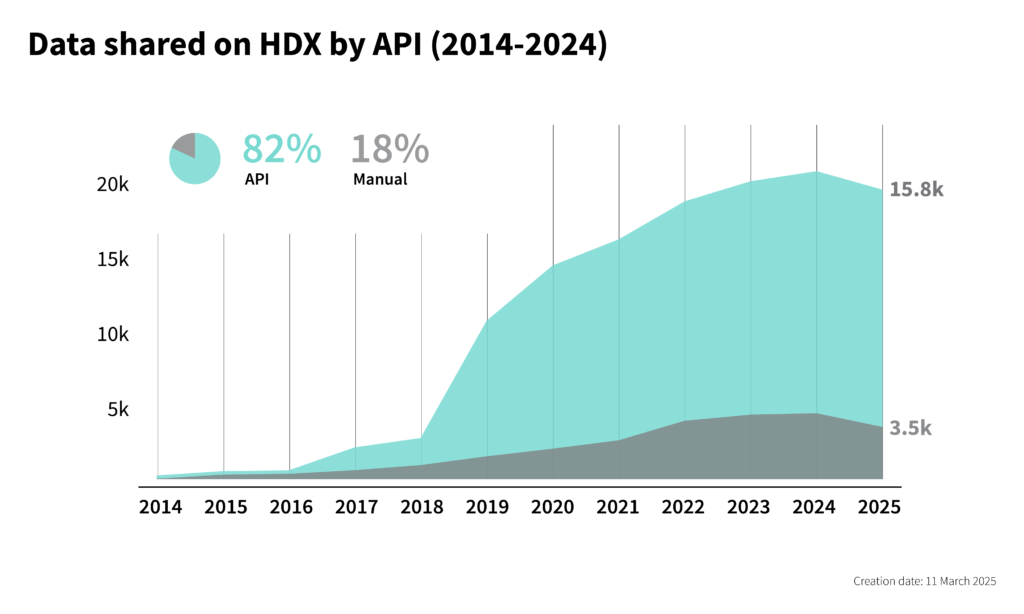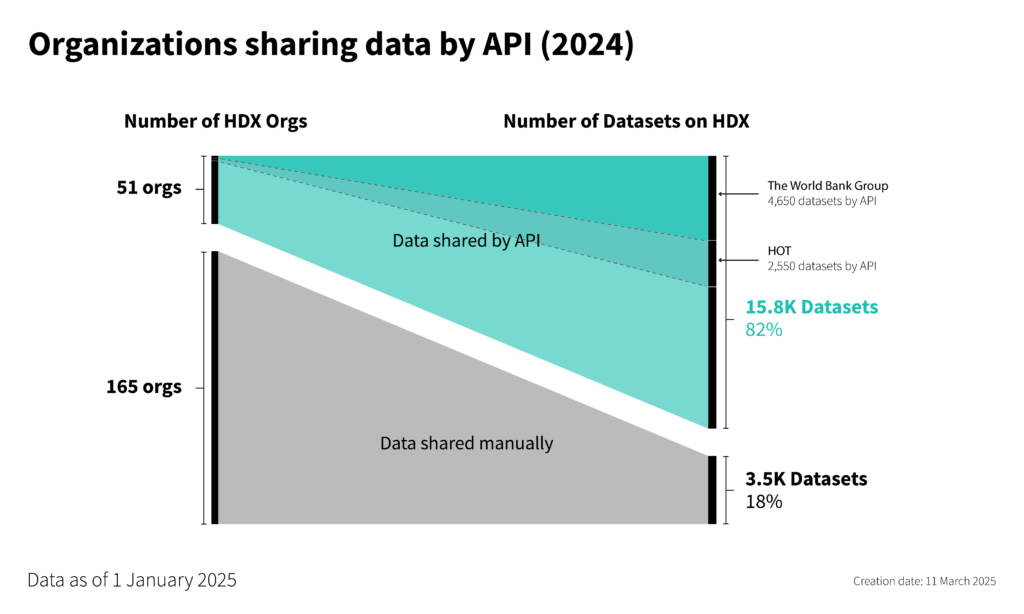Share
This article initially appeared in The State of Open Humanitarian Data 2025.
An Application Programming Interface, or API, is a set of rules and tools that let systems communicate. APIs act as bridges, providing standardized, quick access to data, saving analysts and data scientists time from manually downloading and processing individual spreadsheets.
The use of APIs in the humanitarian sector has grown significantly in recent years. By the end of 2024, around 80 percent of the almost 20,000 datasets on HDX were updated through automated processes. This data is shared by 51 of the 216 organizations on HDX, or just under 25 percent of the total (see table at end of article). Eleven of the 16 organizations that contribute to the Data Grids share their data via API.
 Although a useful advance, APIs may not always be the best way to share data. For data that does not change over time, an API may introduce unnecessary complexity without significant benefits. Additionally, the urgency of humanitarian crises can limit the time and resources available for organizations to publish their data using APIs, particularly when existing information systems are already meeting local needs.
Although a useful advance, APIs may not always be the best way to share data. For data that does not change over time, an API may introduce unnecessary complexity without significant benefits. Additionally, the urgency of humanitarian crises can limit the time and resources available for organizations to publish their data using APIs, particularly when existing information systems are already meeting local needs.
Nevertheless, there is growing recognition of the value that APIs bring in streamlining data sharing and enabling faster, data-driven decision making for crisis response. Over the past year, organizations such as IOM and OCHA invested in APIs to improve access and analysis of high-value operational data with positive results.
IOM’s Displacement Tracking
The Displacement Tracking Matrix (DTM) is IOM’s primary data collection programme, providing critical information on internal displacement and human mobility. IOM is a long-time partner of HDX, sharing DTM internal displacement datasets covering 51 countries. Over the past several years, in response to the growing demand for regional and global trend analysis, IOM undertook an effort to standardize its data. It launched the DTM API in 2024.
Before this, large swathes of DTM data varied by country in structure and content, making cross-location and historical analysis time consuming. For example, understanding five years of displacement trends in Mozambique or Ethiopia required downloading and connecting 119 and 62 Excel files respectively, a resource-intensive process.
The DTM API provides standardized data on dates, locations (all p-coded per OCHA’s Common Operational Datasets) and the number of internally displaced persons dating back to 2010. This enables partners to access and analyze data seamlessly. Since its introduction in July 2024, the DTM API has been accessed over 82,000 times. (The IOM DTM API provides data at the admin 1 level, while the IOM DTM data that is shared manually on HDX is at the admin 2 or admin 3.)
“The DTM API has been invaluable for integrating displacement data into our automated pipeline, allowing us to better identify and monitor IDP hotspots within the region. Having direct access to IOM’s data has significantly improved our ability to conduct timely and data-driven risks assessments. We are truly grateful for this resource and the value it has brought to our work.”
-Dr. Mohammed A. Yusuf, Epidemiologist, Polio Eradication Program, WHO Africa Regional Office
OCHA’s Humanitarian Programme Cycle Tools
In 2024, OCHA also prioritized automation by further developing its API for the Humanitarian Programme Cycle (HPC) Tools. This data includes information on people in need, targeted and reached through UN-coordinated humanitarian responses. It also includes data on projects and funding requirements.
Previously, data on humanitarian needs was updated manually on HDX by OCHA country offices on an annual or bi-annual basis. However, humanitarian situations are highly dynamic, with numbers constantly changing. This often led to outdated information and inconsistencies as partners relied on differing figures from various sources. The HPC Tools API now includes global coverage of humanitarian needs data across all relevant locations, ensuring that stakeholders, platforms (including HDX) and dashboards have access to consistent, up-to-date figures, minimizing discrepancies.
The HPC Tools API was used during the famine that was declared in Sudan in 2024, where frequent data updates and rapid analysis were critical. OCHA used the API to develop a Sudan dashboard, which provided real-time insights into the evolving crisis, ensuring a coordinated response.
Data from the HPC Tools API is available on HDX for more than 25 countries, with plans to include cluster activities and monitoring data in the coming year.
HDX’s Humanitarian API
Given progress with APIs in the sector, HDX launched the Humanitarian API, known as HAPI, in June 2024 to streamline access to multiple partner APIs and other high-value datasets in one place. The initial release of HAPI mirrored coverage of the locations and sub-categories in the HDX Data Grids but this has since been expanded. HAPI consolidates and standardizes critical data on conflict events, food security, humanitarian needs, internal displacement and more.
Additionally, the interoperable HAPI datasets are available for download on the HDX platform, catering to less technical users who may not be familiar with APIs. This dual approach serves a broad range of humanitarian actors by providing flexible access to the data. Over the next year, HAPI will incorporate geospatial data, including administrative boundaries and the location of health and education facilities, as well as additional partner data.
Investing in APIs
The benefits of APIs – faster data sharing, aligned crisis figures and enhanced coordination – make continued investment in their development essential. In humanitarian operations, the process of standardizing data and maintaining an API can be resource intensive. Transitioning to automated data sharing can be especially challenging for smaller organizations.
There are also risks. If an API fails, it can disrupt the information systems of the organizations consuming the data. Relying solely on a single entity’s API can be a major point of failure if the data is not stored or backed-up. Additionally, there can be security risks if authentication systems are not properly implemented for API access.
Despite these challenges, optimism around the growing use of APIs persists. As Robert Trigwell, Senior DTM Coordination Officer at IOM, sees it: “Sharing data via APIs is the future. The days of transferring data files via USB or downloading and analyzing datasets one by one are behind us. Today’s analytical demands require a different approach. Humanitarian organizations must design data collection with API sharing and data governance in mind from the very beginning and plan accordingly.”
However, APIs are only part of the equation. As OCHA’s Bassil Aleter explains: “APIs enable dynamic and timely analysis, bringing situational awareness closer to real time. For humanitarian organizations to fully leverage APIs, they should also invest in tools that visualize or present connected data, facilitating meaningful insights.”

Please reach out with questions or comments at hdx@un.org.